Need help? We're here to assist you!
Thank You for Enquiry, we will contact you soon!
Close
The Class 9 is an important year in a student’s life and Maths is one of the subjects that require dedication, hard work, and practice. It’s a subject where you can score well if you are well-versed with the concepts, remember the important formulas and solving methods, and have done an ample amount of practice. Worry not! Home Revise is here to make your Class 9 journey even easier. It’s essential for students to have the right study material and notes to prepare for their board examinations, and through Home Revise, you can cover all the fundamental topics in the subject and the complete NCERT Class 9 Maths Book syllabus.

Exercise 11.1 Page: 191
1. Construct an angle of 90° at the initial point of a given ray and justify the construction.
Construction Procedure:
To construct an angle 90°, follow the given steps:
1. Draw a ray OA.
2. Take O as a centre with any radius, and draw an arc DCB that cuts OA at B.
3. With B as a centre with the same radius, mark a point C on the arc DCB.
4. With C as a centre and the same radius, mark a point D on the arc DCB.
5. Take C and D as the centres, and draw two arcs which intersect each other with the same radius at P.
6. Finally, the ray OP is joined, which makes an angle of 90° with OA.
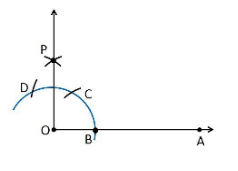
Justification
To prove ∠POA = 90°
In order to prove this, draw a dotted line from the point O to C and O to D, and the angles formed are:

From the construction, it is observed that
OB = BC = OC
Therefore, OBC is an equilateral triangle
So that, ∠BOC = 60°.
Similarly,
OD = DC = OC
Therefore, DOC is an equilateral triangle
So that, ∠DOC = 60°.
From SSS triangle congruence rule,
△OBC ≅ OCD
So, ∠BOC = ∠DOC [By C.P.C.T]
Therefore, ∠COP = ½ ∠DOC = ½ (60°).
∠COP = 30°
To find the ∠POA = 90°:
∠POA = ∠BOC+∠COP
∠POA = 60°+30°
∠POA = 90°
Hence, justified.
2. Construct an angle of 45° at the initial point of a given ray and justify the construction.
Construction Procedure:
1. Draw a ray OA.
2. Take O as a centre with any radius, draw an arc DCB that cuts OA at B.
3. With B as a centre with the same radius, mark a point C on the arc DCB.
4. With C as a centre and the same radius, mark a point D on the arc DCB.
5. Take C and D as the centres, and draw two arcs which intersect each other with the same radius at P.
6. Finally, the ray OP is joined, which makes an angle of 90° with OA.
7. Take B and Q as the centres, and draw the perpendicular bisector which intersects at the point R
8. Draw a line that joins the points O and R
9. So, the angle formed ∠ROA = 45°
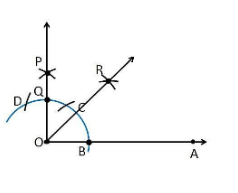
Justification
From the construction,
∠POA = 90°
The perpendicular bisector from points B and Q divides the ∠POA into two halves. So it becomes
∠ROA = ½ ∠POA
∠ROA = (½)×90° = 45°
Hence, justified

Solution:
(i) 30°
Construction Procedure:
1. Draw a ray OA
2. Take O as a centre with any radius, and draw an arc BC which cuts OA at B.
3. With B and C as centres, draw two arcs which intersect each other at point E, and the perpendicular bisector is drawn.
4. Thus, ∠EOA is the required angle making 30° with OA.
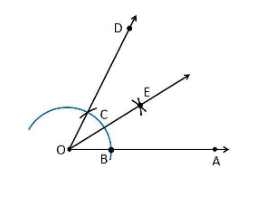

Construction Procedure:
1. Draw an angle ∠POA = 90°.
2. Take O as a centre with any radius, and draw an arc BC which cuts OA at B and OP at Q
3. Now, draw the bisector from points B and Q, where it intersects at the point R such that it makes an angle ∠ROA = 45°.
4. Again, ∠ROA is bisected such that ∠TOA is formed, which makes an angle of 22.5° with OA

(iii) 15°
Construction Procedure:
1. An angle ∠DOA = 60° is drawn.
2. Take O as the centre with any radius, and draw an arc BC which cuts OA at B and OD at C
3. Now, draw the bisector from points B and C, where it intersects at point E such that it makes an angle ∠EOA = 30°.
4. Again, ∠EOA is bisected such that ∠FOA is formed, which makes an angle of 15° with OA.
5. Thus, ∠FOA is the required angle making 15° with OA.
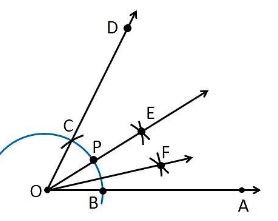
4. Construct the following angles and verify by measuring them with a protractor:
(i) 75° (ii) 105° (iii) 135°
Solution:
(i) 75°
Construction Procedure:
1. A ray OA is drawn.
2. With O as the centre, draw an arc of any radius and intersect at point B on the ray OA.
3. With B as the centre, draw an arc C, and with C as the centre, draw an arc D.
4. With D and C as the centres, draw an arc that intersects at point P.
5. Join points O and P.
6. The point that the arc intersects the ray OP is taken as Q.
7. With Q and C as the centres, draw an arc that intersects at point R.
8. Join points O and R.
9. Thus, ∠AOE is the required angle making 75° with OA.
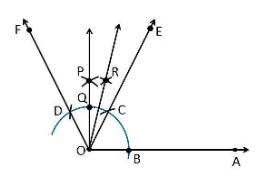
(ii) 105°
Construction Procedure:
1. A ray OA is drawn.
2. With O as the centre, draw an arc of any radius and intersect at point B on the ray OA.
3. With B as the centre, draw an arc C, and with C as the centre, draw an arc D.
4. With D and C as the centres, draw an arc that intersects at point P.
5. Join the points O and P
6. The point that the arc intersects the ray OP is taken as Q.
7. With Q and D as the centres, draw an arc that intersects at point R.
8. Join points O and R.
9. Thus, ∠AOR is the required angle making 105° with OA.
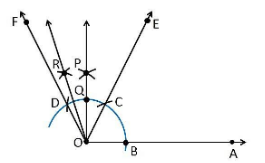
(iii) 135°
Construction Procedure:
1. Draw a line AOA‘
2. Draw an arc of any radius that cuts the line AOA‘ at points B and B‘
3. With B as the centre, draw an arc of the same radius at point C.
4. With C as the centre, draw an arc of the same radius at point D.
5. With D and C as the centres, draw an arc that intersects at point P.
6. Join OP.
7. The point that the arc intersects the ray OP is taken as Q, and it forms an angle of 90°.
8. With B‘ and Q as the centre, draw an arc that intersects at point R.
9. Thus, ∠AOR is the required angle making 135° with OA.

5. Construct an equilateral triangle, given its side and justify the construction.
Construction Procedure:
1. Let us draw a line segment AB = 4 cm.
2. With A and B as centres, draw two arcs on the line segment AB and note the point as D and E.
3. With D and E as centres, draw the arcs that cut the previous arc respectively that forms an angle of 60° each.
4. Now, draw the lines from A and B that are extended to meet each other at point C.
5. Therefore, ABC is the required triangle.
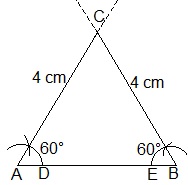
Justification:
From the construction, it is observed that,
AB = 4 cm, ∠A = 60° and ∠B = 60°
We know that the sum of the interior angles of a triangle is equal to 180°
∠A+∠B+∠C = 180°
Substitute the values
⇒ 60°+60°+∠C = 180°
⇒ 120°+∠C = 180°
⇒∠C = 60°
While measuring the sides, we get,
BC = CA = 4 cm (Sides opposite to equal angles are equal)
AB = BC = CA = 4 cm
∠A = ∠B = ∠C = 60°
Hence, justified.
Exercise 11.2 Page: 195
1. Construct a triangle ABC in which BC = 7cm, ∠B = 75° and AB+AC = 13 cm .
Construction Procedure:
The steps to draw the triangle of the given measurement are as follows:
1. Draw a line segment of base BC = 7 cm.
2. Measure and draw ∠B = 75° and draw the ray BX.
3. Take a compass and measure AB+AC = 13 cm.
4. With B as the centre, draw an arc at the point D.
5. Join DC.
6. Now draw the perpendicular bisector of the line DC, and the intersection point is taken as A.
7. Now join AC.
8. Therefore, ABC is the required triangle.

2. Construct a triangle ABC in which BC = 8cm, ∠B = 45° and AB–AC = 3.5 cm .
Construction Procedure:
The steps to draw the triangle of the given measurement are as follows:
1. Draw a line segment of base BC = 8 cm
2. Measure and draw ∠B = 45° and draw the ray BX
3. Take a compass and measure AB-AC = 3.5 cm.
4. With B as the centre, draw an arc at point D on the ray BX.
5. Join DC.
6. Now draw the perpendicular bisector of the line CD, and the intersection point is taken as A.
7. Now join AC.
8. Therefore, ABC is the required triangle.
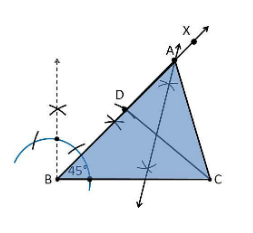
3. Construct a triangle PQR in which QR = 6cm, ∠Q = 60° and PR–PQ = 2cm.
Construction Procedure:
The steps to draw the triangle of the given measurement are as follows:
1. Draw a line segment of base QR = 6 cm
2. Measure and draw ∠Q = 60° and let the ray be QX.
3. Take a compass and measure PR–PQ = 2cm.
4. Since PR–PQ is negative, QD will be below the line QR.
5. With Q as the centre, draw an arc at point D on the ray QX.
6. Join DR.
7. Now draw the perpendicular bisector of the line DR and the intersection point is taken as P.
8. Now join PR.
9. Therefore, PQR is the required triangle.
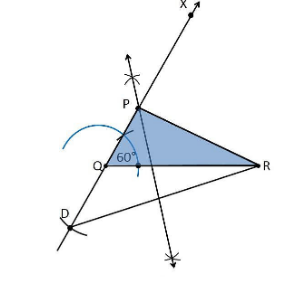
4. Construct a triangle XYZ in which ∠Y = 30°, ∠Z = 90° and XY+YZ+ZX = 11 cm.
Construction Procedure:
The steps to draw the triangle of the given measurement are as follows:
1. Draw a line segment AB which is equal to XY+YZ+ZX = 11 cm.
2. Make an angle ∠LAB = 30° from the point A.
3. Make an angle ∠MBA = 90° from the point B.
4. Bisect ∠LAB and ∠MBA at point X.
5. Now, take the perpendicular bisectors of the lines XA and XB, and the intersection points are Y and Z, respectively.
6. Join XY and XZ.
7. Therefore, XYZ is the required triangle

5. Construct a right triangle whose base is 12cm and sum of its hypotenuse and other side is 18 cm.
Construction Procedure:
The steps to draw the triangle of the given measurement are as follows:
1. Draw a line segment of base BC = 12 cm
2. Measure and draw ∠B = 90° and draw the ray BX.
3. Take a compass and measure AB+AC = 18 cm.
4. With B as the centre, draw an arc at point D on the ray BX.
5. Join DC.
6. Now draw the perpendicular bisector of the line CD, and the intersection point is taken as A.
7. Now join AC.
8. Therefore, ABC is the required triangle.
